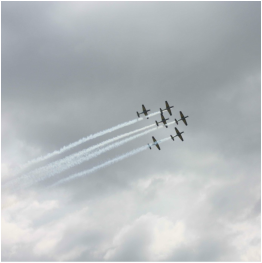This picture was taken in the old town of Panama City. Chances are that the pilots of these jets were all male. Nevertheless, there have been outstanding female pilots for decades. One, Helen Richey, came to fame in the early 1930s when she climbed onto the wing of a plane she was flying to repair a tear. That same woman was later barred from becoming a member of the Pilot’s Union and forbidden from flying in anything other than fair weather, due to her sex. |
According to the International Society of Women Airline Pilots, only 3 percent of commercial pilots are female (4,000 out of 130,000 worldwide), the majority of them in the United States. A few more hold licenses but don’t fly commercially. Aviation is not a sector covered by UNIDO, but I have been looking at parallels in other sectors, such as Information and Communication Technology (ICT), engineering, manufacturing, investment, etc.
While women account for about 20 percent of engineering graduates, they represent only about 11 percent of practicing engineers. In ICT, women account for about 20 percent of jobs, but only 11 percent among IT strategy and planning professionals (according to the International Telecommunication Union). The proportion of women in manufacturing differs widely globally, ranging from as low as 4 percent in Kuwait to around 10 percent in India and Iran, to 55 percent in Sri Lanka and 58 percent in Vietnam. Within countries there are stark differences between sectors. For example, in Ethiopia women account for 31 percent in total manufacturing; 50 percent in textile and chemical manufacturing; 16 percent in electrical machinery and apparatus manufacturing; and only 2 percent in machinery and equipment manufacturing (UNIDO statistics). You get the idea.
What explains those gender disparities? What do these sectors have in common? Is it because of sexist or discriminatory work environments? Is it the fact that in most societies women still bear the brunt of domestic work? In aviation, does it have to do with the military as an entry point into flying, helping future pilots get around otherwise prohibitive training costs? Or are gender stereotypes by clients and customers to blame (there have been cases of passengers stepping off a plane when realising that a woman was going to fly it)?
A mix of reasons probably is the answer. However, reasons commonly brought forward, such as time commitments and willingness to spend time away from home, do not explain why women are abundantly present in lower-level positions (think cabin crews which are predominantly female) while being absent in higher-level positions. Above all, women’s underrepresentation in specific sectors may have to do with a lack of role models getting young women interested in these sectors. As airlines, engineering schools and other institutions make efforts to attract women, gender equality is improving slowly but surely.
And this is absolutely crucial since companies cannot afford to miss out on half of the population when looking for the best candidates for a given job. The next time I step on a plane I certainly want the best pilots in the cockpit, regardless of their sex. In other words, I would like to know that they are the best available pilots, not just the best available men.
PS: While it is mostly women who are discriminated against, and this is what this blog focuses on, there are of course many cases of men being treated unfairly as well. For example, there is evidence that in textile manufacturing - an industry where cleanliness is highly important - men are discriminated against as they are perceived to be ‘dirtier’ than women.


 RSS Feed
RSS Feed